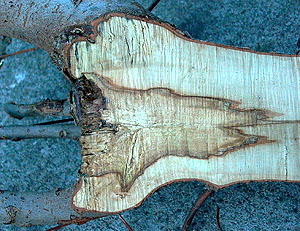Home > Pruning shade trees > Restoration pruning > Restoring topped trees > Storms and topping
Storms and topping
 Note the advancing decay just behind the topping cut on this sweetgum just one year after pruning. |
Trees recently damaged in a storm should be cleaned of broken and hanging branches. Make smooth clean reduction cuts with sharp tools preferably back to living lateral branches that are at least one-third the diameter of the cut branch. If branches of this size are not present nearby the damaged or broken branch, make a clean heading cut.
If a tree has been storm-damaged, topped (see photo), tipped, or lion tailed and has sprouted vigorously, restoration can improve structure and appearance. Restoration consists of the selective removal of some water sprouts, stubs, and dead branches to improve a tree's structure and form. On trees with many sprouts originating at the tips of branches, one to three sprouts on main branch stubs are selected to become permanent branches and to re-form a more natural-appearing crown. Some vigorous sprouts may need to be shortened to control growth and ensure adequate attachment for the size of the sprout. Lion tailed trees can be restored by allowing sprouts to develop along the interior portion of limbs for one to three years depending on size, age and condition of the tree. Then remove some of the sprouts along the entire length of the limbs so they are evenly distributed. Restoration usually requires several prunings over a number of years.

